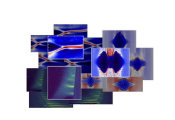Thin Materials and Fat Electrons: A Recipe for New Quantum Phenomena
July 16, 2025 - Heavy fermion materials contain magnetic ions of elements known as lanthanides and actinides in the Periodic Table of Elements. The electrons in these heavy fermion materials get tangled and slowed down by the magnetic ions. This makes the electrons, which are a type of fermion, behave as if they had a much greater mass. This is why they are called heavy fermion materials. In conventional metals like copper, electrons effectively behave like a gas. In heavy fermion materials, the electrons instead strongly interact and behave like a sluggish liquid. Strong interactions among electrons are associated with many exotic behaviors, including superconductivity, where electrical currents have zero resistance. Heavy fermions have been studied for many years because scientists know that by tweaking the interplay between electrons and magnetic ions, they can cause the material to become a superconductor. Until now, all known heavy fermions have a 3D crystal structure, like kitchen salt or diamonds. But recently, researchers were able to make these materials in 2D form.
The Impact
Why are 2D heavy fermions so interesting? 2D materials are just a few atoms thick but extend over thousands of atoms in length and width. This geometry restricts the ways electrons can move. In conventional materials, electrons can effectively avoid each other like cars flying through 3D space. In 2D materials, electrons are forced to interact with each other, like cars in a traffic jam. Scientists think that 2D heavy fermions will be easier to tune and turn into superconductors or other quantum phases of matter, much like shrinking semiconductors to quantum dots led to new quantum phenomena, as celebrated in the 2023 Nobel Prize.
Summary
By dropping one of the dimensions in heavy fermion materials, scientists hope to uncover a new paradigm to probe novel quantum phases of matter. In a 2D material, electron-electron correlations are enhanced, and magnetic order suppressed. According to recent research and theoretical considerations, these pathways are promising for tuning the so-called Kondo interaction in heavy fermions. This would allow researchers to bring the material close to a quantum critical region where superconductivity can emerge.
2D heavy fermions are a rare class of materials that were sought for years but never found until now. By scanning crystallographic databases, researchers choose to study cerium silicon iodide (CeSiI). This material has three key ingredients: cerium atoms, which provide a magnetic moment; metallic conductivity, which is linked to freely moving electrons; and a van der Waals layered structure from which atomically thin layers can be peeled off. By using scanning tunneling microscopy, photoemission spectroscopy, and other probes of electronic structure, the researchers proved that CeSiI indeed hosts heavy fermions. Most importantly, the researchers established that the physical signatures of heavy fermions behavior were retained in thin samples made of just four layers. They also saw small shifts in the magnetic transition when comparing the thin flakes with bulk samples, suggesting that one day, it might be possible to tune the Kondo interaction just by controlling the sample thickness.




































